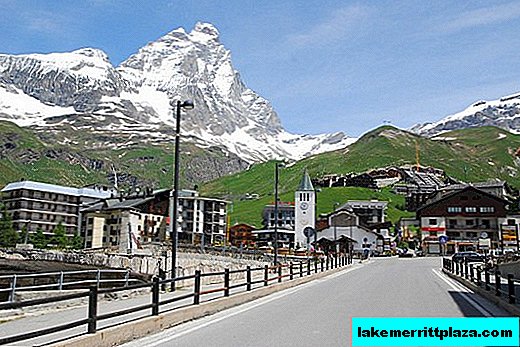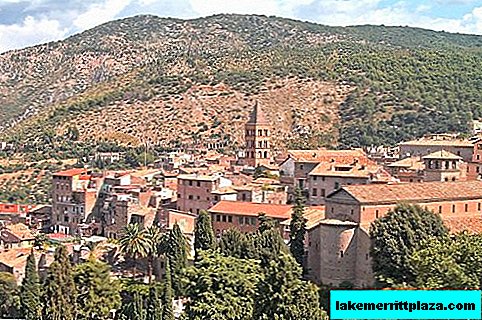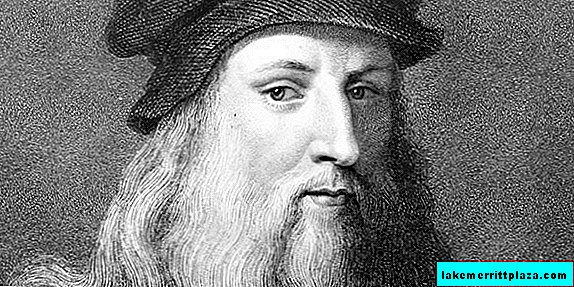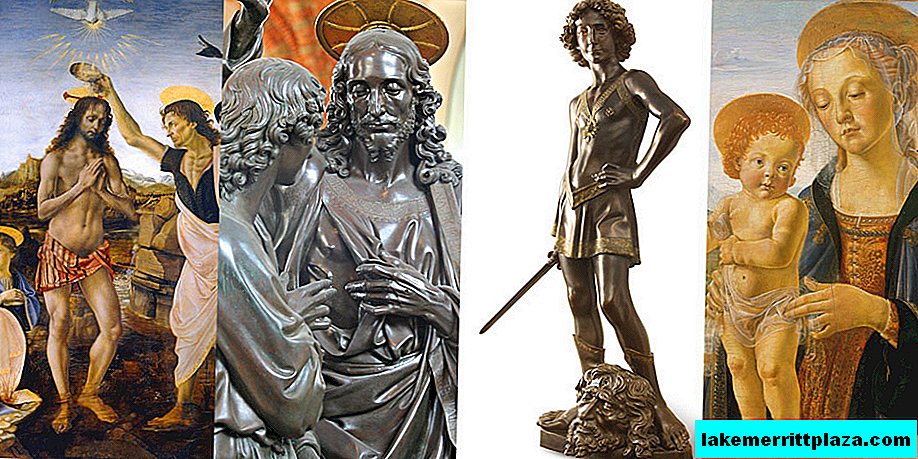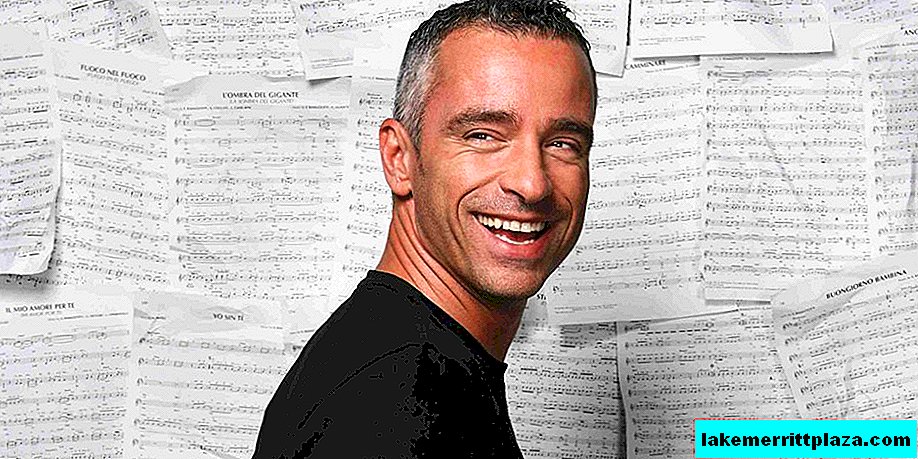Santa Maria Maggiore is on the list of 7 Roman pilgrimage basilicas. This is one of the most important monuments of early Christian art, one of the most beautiful European basilicas, a great example of world baroque.

In the square in front of the Basilica of Santa Maria Maggiore
Santa Maria Maggiore (Basilica di S. Maria Maggiore) is one of the 4 main basilicas of Rome, which is spoken of in superlatives. Its square bell tower with a cross spire proudly rises above the ancient city. The grand front facade opens onto the eponymous square. The clock on the campaign tower counts the time from the 19th century. Santa Maria Maggiore holds the highest title of the Catholic Church - the papal basilica.
Construction history
The first temple on Esquiline, the Liberian Basilica, was laid in 356 by the will of the Bishop of Rome - Pope Liberia. With the foundation of this church is connected a historical legend about the snow that fell in August. This legend is told to tourists visiting Santa Maria Maggiore: “Pope Liberia and aristocrat Giovanni Patrizio had a vision at the same time. The Virgin appeared to them in a dream and ordered to build a temple. The church was supposed to grow where snow would fall. Until then, in the summer in Rome there was never snow. Snow fell on the morning of August 5, 352 on Esquiline and indicated to the bishop the place of construction of the church, which was built with the money of the wealthy Roman Giovanni Patrizio. Every year on this day, parishioners of the temple are showered with white petals.
Church of the Mother of God in the snow - that was the name of the temple. After construction, the church received a different name - Santa Maria Liberiana, named after the Bishop of Liberia, who built it. Santa Maria Prespepe (Madonna with a manger) - she received this name when a relic appeared in the form of pieces of a manger. And it was finally renamed to Santa Maria Maggiore in 431 in preparation for the Ephesus Cathedral in Rome.
The first building has not survived to the present day. The basilica that we see today appeared later - in 440, on the site of the ancient villa of Neratsiev. The heads of the Catholic Church were replaced, the building was being improved: it was being completed, expanded, reconstructed. Many changes in the structure of the temple occurred in the 9th century and in the period 1288-92. The high campaign was erected in 1377, instead of the old tower, destroyed by thunderstorms and earthquakes. Since 1614, when the plague left Rome, a Marian column was erected opposite the front door. In the years 1740-58. built a new main facade and reconstructed the left block according to the project of F. Fugue. The modern look of Santa Maria Maggiore dates back to the 18th century, but fragments of the early Christian church are still hidden in the heart of the building.
Architecture

Santa Maria Marjore - the pride of Rome, one of the greatest Catholic basilicas
The main entrance to the basilica is designed as a massive open portico with a colonnade. Above it rises a three-arched loggia - "The Blessing Lodge" (from it the pontiff blesses the laity when he holds Mass), crowned with a statue of Our Lady by Lironi and four figures of the Popes (Benedict XIV, Gregory the Great, Sixtus III and Easter I). The portal is different in style from the walls surrounding it: the ancient power of the colonnade contrasts with the Baroque grace of the neighboring facade blocks. A balustrade along the perimeter of the roof connects the architectural composition into a single whole.
The main nave is covered with a low gable roof. Above it rises the pyramidal dome of the 75-meter bell tower. An elegant campaignana with marble cornices, erected on the basis of the early Christian tower, stands above the right nave. The brick structure has six tiers: four of them rise above the facade, two are hidden inside. With the last reconstruction of 1800-23. the tower was equipped with a lightning rod. Two large side chapels, Paolinskaya and Sistinskaya, are covered with lead octagonal domes.
The eastern facade was built in 1673 by the architect Carlo Rainaldi. He combined the Romanesque apse (a semicircular protrusion in the center) with the late medieval chapels, crowning the apse with a carved balustrade and a semi-dome.

Obelisk column at the entrance to the temple, crowned with a statue of the Virgin
To the eastern portal today leads a curved wide staircase, separated by a lattice from the square. In front of the entrance is a 15-meter pilgrimage obelisk (1614), crowned with a statue of the Holy Virgin, taken from the Roman Forum.
The facade of the Paolin Chapel was decorated in 1611 by the court architect Flaminio Ponzio. Adjacent to it is the wall of the late baroque Palazzo Canon, built by Ferdinando Fuga. The Sistine Chapel adjoins the apse on the left side. Behind her is the sacristy created by Flaminio Ponzio.
Five doors open from the portico of the basilica: three to the central nave, one to the bell tower. Another door is Porta Santa, the famous Holy Gate: they are opened only on Anniversaries (once every 25 years). On the gates created by Luigi Enzo Matei, you can see the reliefs of Our Lady and Christ. The hands of the bronze images are polished to a golden glow. Believers approach the Holy Gates and pray, holding the Virgin and Savior by the hands.
Interior decoration
The interior of the temple has changed little over the centuries! The decoration of the spacious temple impresses with its luxury and solemn atmosphere. Here a huge number of paintings and mosaics, a lot of statues, relief images. Above the main entrance there is a round window with a multi-color stained-glass window "Mother of the Church" by modern master Janos Hajnal (1995).

Central nave of the basilica, photo by Paul Fuller
The main nave is highlighted with marble columns with capitals; on the colonnades a carved gilded entablature is held. The side walls are decorated with frescoes in the mannerism style with Old Testament scenes. Mosaics (V c.) Have been preserved above the columns. Initially, the temple had 42 medieval mosaic panels. Only 36 survived, in good condition - only 25. A mosaic panel (V c.) In the early Byzantine style adorns the triumphal arch. The skillful mosaics of the apse are made in the 13th century.
Floors in the central nave are made in the style of "cosmatesco" in the XII century. They are made of valuable marble of 5 species and colors, in the form of complex geometric patterns. The floors were restored in the 18th century.
The pride of Santa Maria Maggiore is the golden coffered ceiling above the main nave, created by Leon Alberti and Giuliano da Sangallo. At the center of each cassette is a graceful rose. The strict geometry of the rows of gilded elements and the delicate lace of the ornament are striking. The light from the windows falls on the gilding, and it shines brightly in the rays of the sun. Gold for this ceiling was donated to Pope Alexander VI by the kings of Spain - Ferdinand and Isabella.

Solemn canopy above the papal altar, photo Dnalor 01
Over the papal altar in the apse rises a magnificent canopy on 4 columns entwined with gilded branches, and above it is a triumphal arch with mosaics. The spherical dome vault of the apse is decorated with caisson panels. The composition of the altar was created in 1750 by Ferdinando Fugue and master Pietro Bracci; the image for the sanctuary was written in 1635 by the Roman painter Giuseppe Puglia.
Bethlehem Crypt
In front of the papal throne is an open crypt, lined with colored marble. Here, in a silver reliquary, 5 small pieces of a wooden feeding trough (nursery) are stored, where baby was laid after his birth. Pope Pius V is also buried in the crypt and the remains of St. Jerome are buried (but this fact has not been proved). Nearby, under the floor stove, hides the entrance to the tomb of the Bernini family. The baptistery of the temple has preserved an antique marble font donated by the Vatican Museum. It is installed below the floor, ringed with a balustrade and circular steps.
Chapels
There are several side chapels in the basilica. Three large outside chapels are of particular interest to tourists.
Paolin Chapel

Cappella Borghese, photo edk7
The Pauline Cappella or Borghese Chapel, built in the shape of a reverse Latin cross, is located to the left of the main nave: the entrance arch is located at the papal altar. The chapel was built by the will of Pope Paul V (Borghese). Here in porphyry sarcophagi lie Paul V himself and Clement VIII; nearby is the entrance to the family tomb of the Borghese family. The interior of the chapel is designed in a bright, expressive, almost mystical spirit. The dome vault is covered with polychrome painting, the walls shine with gold. The decoration stands out for statues and reliefs, deep rich tones of mural painting, green marble frieze. The second tier is supported by four caryatids by Bernini.
The Sistine Chapel

Sistine Chapel (Cappella Sistina), photo Luc & Ca
The Sistine Chapel (Cappella Sistina), built in the form of a classical Latin cross, is located to the right of the central nave, behind the altar of the Annunciation. It was created at the behest of Pope Sixtus V. The author of the project was Domenico Fontana. For decoration, he took colored marble slabs from the ruins of Septisodium. The interior uses Florentine mosaics, the dome drum is painted with light polychrome frescoes. The entrance arch is crowned by the painting "The Birth of the Virgin" by Aureliano Milani (1742). To the left lie the imperishable relics of Pius V; on the right is the tomb of Sixtus V.
Sforza Chapel
The Sappa Chapel (Cappella Sforza) is also on the right, behind a small entrance lobby. It was built by Tiberio Calcagni and Giacomo della Porta. It is believed that the late project of Michelangelo was taken as the basis of Sforza. The interiors of the chapel are designed in cold light gray tones, with a minimal relief design. The altar with the image of the Ascension of Our Lady is made of greenish marble.
Relics
Holy day nursery

Sculpture of Pope Pius IX in front of the Holy manger, photo naruchai.janteb
Santa Maria Marjorie holds some of the greatest relics of the Christian world. In front of the main altar of the basilica, in the crypt of Bethlehem, is a small silver reliquary by Giuseppe Valadier, which houses the shrine - ad Praesepem. These are several plaques preserved from the wooden manger in which the magi found the newborn Christ. Empress Helen gave the shrine to the temple. Particles of a manger are visible through the crystal wall of a gilded vessel, decorated with the figure of Jesus the baby. The relic is displayed for viewing only during the Christmas Mass.
The Holy Relics of Pope Pius V
In the Sistine Chapel, under the statue of Pope Pius V by Leonardo Sormani, a reliquary of black marble is installed. Inside, a wax figure is stored, in which the relics of the pontiff are enclosed.
The miraculous icon of the Madonna "Salvation of the Roman People"
Since 1613, the Paolin Chapel has been preserving the image of Salus Populi Romani - the sacred miraculous icon of the Madonna "The Salvation of the Roman People." They say that this is the work of the evangelist Luke, but historians attribute the image to the VI-VII century. With this icon, Pope Gregory the Great walked the Roman streets in 593, expelling the plague. The life-giving icon saved Rome from the terrible cholera epidemic of 1837, when the procession was led by Pope Gregory VI.
Museum
In 2001, Pope John Paul II opened a museum dedicated to the history of Santa Maria Maggiore and the Christian religion. In 8 rooms, church utensils and papal clothes, books and documents, works of art and other treasures are collected. The museum is located in the basement of the temple.
Museum time: Mon-Sun 09: 30-18: 30.
How to get there
Take the metro to Termini Station;
by tram 5, 14 to the stop Farini;
by bus 16, 50, 70, 71, 75, 105, 150F, 360, 649, 714, 717, No. 1, No. 12, No. 18 to the stop S. Maria Maggiore.



